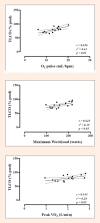Lung Diffusion Capacity can Predict Maximal Exercise in Apparently Healthy Heavy Smokers
- PMID: 24149454
- PMCID: PMC3761463
Lung Diffusion Capacity can Predict Maximal Exercise in Apparently Healthy Heavy Smokers
Abstract
Chronic exposure to tobacco smoking may damage lung and heart function. The aim of this study was to assess maximal exercise capacity and its relationship with lung function in apparently healthy smokers. We recruited 15 heavy smokers (age 47 years ± 7, BMI 25 kg/m(2) ± 3, pack/years 32 ± 9) without any cardiovascular or pulmonary signs and symptoms. Fifteen healthy non smoking subjects were enrolled as a control group. All subjects underwent pulmonary function tests, electrocardiograms at rest and graded cycle exercise tests. In smokers and controls, resting lung and cardiac function parameters were in the normal range, apart from diffusing lung capacity (TLCO) values which were significantly lower in smokers (p < 0.05). As compared to controls, smokers presented lower maximal exercise capacity with lower values at peak of exercise of oxygen uptake (peak VO2), workload, oxygen uptake/watt ratio and oxygen pulse (p < 0.05) and higher dyspnoea perception (p < 0.05). Moreover, peak VO2, maximal workload and oxygen pulse at peak exercise were related to and predicted by TLCO (p < 0. 05). Our study confirms that maximal exercise capacity is reduced in apparently healthy heavy smokers, and shows that TLCO explains some of the variance in maximal exercise. Key pointsChronic exposure to tobacco smoking may damage lung and heart function.Smokers present lower diffusion capacity and maximal exercise capacity.In smokers maximal exercise capacity can be predicted by resting diffusion lung capacity.
Keywords: Tobacco; exercise capacity; lung diffusion capacity.; lung function.
Figures


Similar articles
-
Resting Physiological Correlates of Reduced Exercise Capacity in Smokers with Mild Airway Obstruction.COPD. 2017 Jun;14(3):267-275. doi: 10.1080/15412555.2017.1281901. Epub 2017 Apr 3. COPD. 2017. PMID: 28368706
-
Exercise intolerance in patients with chronic heart failure: role of pulmonary diffusing limitation.Eur Heart J. 1995 Feb;16(2):201-9. doi: 10.1093/oxfordjournals.eurheartj.a060886. Eur Heart J. 1995. PMID: 7744092
-
Does lung diffusion impairment affect exercise capacity in patients with heart failure?Heart. 2002 Nov;88(5):453-9. doi: 10.1136/heart.88.5.453. Heart. 2002. PMID: 12381630 Free PMC article. Clinical Trial.
-
Exercise tolerance in heart transplant patients with altered pulmonary diffusion capacity.Med Sci Sports Exerc. 1998 Mar;30(3):339-44. doi: 10.1097/00005768-199803000-00002. Med Sci Sports Exerc. 1998. PMID: 9526878
-
Exercise tolerance in patients with mitral stenosis before and after acute percutaneous mitral valvuloplasty. Role of lung diffusing capacity limitation?Eur Heart J. 1996 Apr;17(4):595-605. doi: 10.1093/oxfordjournals.eurheartj.a014914. Eur Heart J. 1996. PMID: 8733094
References
-
- ATS/ACCP Statement on Cardiopulmonary Exercise Testing (2003) American Journal of Respiratory and Critical Care Medicine 167, 211-277 - PubMed
-
- Bernaards C.M., Twisk J.W.R., Van Mechelen W., Snel J., Kemper H.C.G. (2003) A longitudinal study on smoking in relantionship to fitness and heart rate response. Medicine and Science in Sports and Exercise 35, 793-800 - PubMed
-
- Bolinder G., Norén A., Wahren J., De Faire U. (1997) Long-term use of smokeless tobacco and physical performance in middle-aged men. European Journal of Clinical Investigation 27, 427-433 - PubMed
-
- Cardellach F., Alonso J.R., López S., Casademont J., Miró O. (2003) Effect of smoking cessation on mitochondrial respiratory chain function. Journal of Toxicology Clinical Toxicology 41, 223-228 - PubMed
-
- Clark K.D., Wardrobe-Wong N., Elliott J.J., Gill P.T., Tait N.P., Snashall P.D. (1998) Cigarette smoke inhalation and lung damage in smoking volunteers. European Respiratory Journal 12, 395-9 - PubMed
LinkOut - more resources
Full Text Sources
Research Materials
